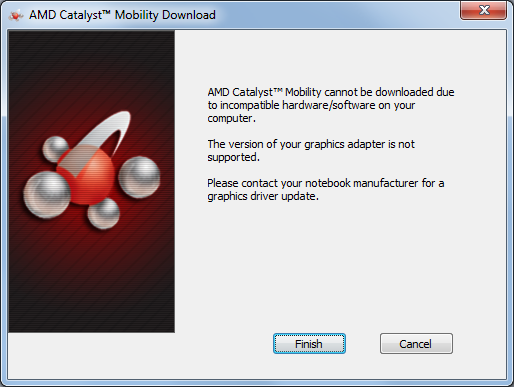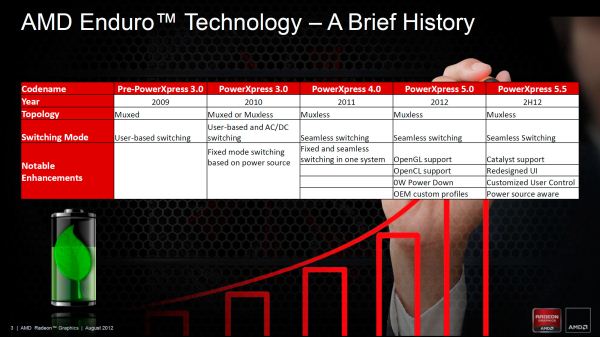AMD’s Enduro Switchable Graphics Levels Up
by Jarred Walton on September 6, 2012 3:00 AM ESTRecap: AMD’s PowerXpress, aka Dynamic Switchable Graphics, aka Enduro
Getting back to the switchable graphics, AMD has gone through a variety of names over the years. Here’s AMD’s summary slide, which I’ll discuss in detail:
Originally introduced as PowerXpress back in 2008, the first AMD switchable graphics solutions were like that found later in the ASUS UL80Vt and similar laptops: you had to flip a switch, and in the first iterations you would then need to reboot the laptop so that the BIOS could disable the discrete GPU and activate the integrated GPU. It was messy and a bit inconvenient, and NVIDIA’s early studies showed that many users ended up not using the feature—they would either run on dGPU all the time or on iGPU all the time. Both AMD and NVIDIA had a second series of switchable graphics designs where the need to reboot was removed; the first Alienware M11x could switch GPUs in about 10-15 seconds, and the same was true of HP’s first ENVY laptops. These were using PowerXpress 2.0 and 3.0, and for most people the switching side was adequate: you’d run on dGPU when plugged in and switch to iGPU when on battery power.
Last year, AMD took a step forward with their switchable graphics by introducing PowerXpress 4.0, which also renamed the technology to Dynamic Switchable Graphics (DSG for short). I got a chance to do a head-to-head of the technology using a Sony VAIO C laptop provided by NVIDIA. You know a company is confident that they’re going to win a technology comparison when they’ll actually give you a competitor’s product. In some cases, DSG was just as good as Optimus: you could launch a supported game and never realize all the extra stuff happening in the background; unfortunately, there were several titles where it wasn’t quite as convenient as we would have liked, and OpenGL support from DSG was completely missing.
Step forward to early 2012 and we got another update to PowerXpress 5.0 (note that PowerXpress is now only used internally by AMD and hasn’t been their marketing name since before PX4.0) along with a rechristening: Dynamic Switchable Graphics was out and Enduro was in. If nothing else, at least it makes my job easier as Enduro is much more concise. There's also the fact that the GPUs are no longer "switching", as the iGPU is always running; now the dGPU is simply supplementing the iGPU when needed. Along with the name change, AMD added OpenGL and OpenCL support to the mix, and with their Zero Core Technology (which is also part of their 7000 series desktop GPUs—a case of mobile design influencing desktops) the need to keep a small portion of the chip alive (aka BACO: Bus Active Chip Off) was removed. OEMs could also ship with custom profiles for applications, so for example Dell might want all of their extra utilities to default to running on the iGPU.

Hopefully this problem goes away next month!
Other than those changes, the UI and driver updates situation on early Enduro solutions remains largely the same as with DSG/PX4.0—and that’s what I initially received with the Clevo P170EM, with drivers from around March 2012. A quick check at AMD’s site also let me know that there weren’t any new drivers available, as the P170EM wasn’t currently supported by the latest Mobility Catalyst drivers.











200 Comments
View All Comments
TokamakH3 - Friday, September 7, 2012 - link
Reading the article, one would never know the P170EM he has is much less powerful than an exactly spec'd MSI or Alienware system, all because of Enduro.sirizak - Thursday, September 6, 2012 - link
Can we get a comment from Anand in here that he is taking this issue up with AMD? He may just have enough reputation to wake them from their slumber on this ongoing and damaging issue.Please Anand, help us fight the good fight!!
silverblue - Thursday, September 6, 2012 - link
I think the fact that Jarred works at AT should be more than enough. :)If AMD are having developmental issues, it'd be nice if they could open up their development more, get more external help. Not every gamer shies away from diagnosing a good problem, and there's a lot of clever people out there who can at least pinpoint issues with certain hardware configurations. All too often, complaints drown everything else out.
hulawafu77 - Thursday, September 6, 2012 - link
Unfortunately AMD is giving the cold shoulder to everyone on this issue. Caveman on Rage3D has confronted a stone wall when inquiring about progress on Enduro. AnandTech did reach out to AMD and all they got was a rumored fix with two drivers for a 12 month period with proper GCN support. That's incredible...We have one tweet for the customers, that's it. Nothing more. If it wasn't for Anandtech here, we wouldn't eve know there is a suppose Enduro 5.5 in the works, if that is actually being worked on. Andandtech was not given a test build on the driver to see if it actually works.
JarredWalton - Thursday, September 6, 2012 - link
This whole article is a result of us "taking it up with AMD". I know people who already bought the product want it fixed yesterday, but that's just not the way things work, especially with driver development. Mess up the drivers in some small way and everyone gets BSODs. Heck, they could have everything ready for the drivers to release and just need to do a solid two months of QA before sending it out to the public. I won't share the specifics, but let me just say that if AMD had given me the beta driver and I had tried to do the install on my own, I'm pretty sure that I would have ended up doing a full reinstall of my OS and apps. That's not because the driver is broken, but the install routine wasn't fully optimized at the time (two weeks ago). That's part of what they're still working on, along with other performance optimizations.Seanzky - Thursday, September 6, 2012 - link
Quick question, Jarred. I'm not trying to put you on the spotlight here, but maybe you know. Obviously, we've already tried reaching out to resellers and even Clevo. Do you think their silence to our inquires means they ignored us or do you think they actually relayed our concerns to AMD? Because if it were the latter, I would think AMD gave them the same assurance AMD gave you which the resellers would do well to relay to us. Your article, I call it the "great hope for Enduro", is the first I've ever heard of AMD working on anything remotely related to the issues we're experiencing. Honestly.What are your thoughts on those because I feel like resellers are somewhat avoiding us based on some of the feedback I've seen. I just want to know this isn't my imagination or paranoia.
JarredWalton - Thursday, September 6, 2012 - link
I think the resellers were trying to avoid telling people that there are no immediate fixes available. I'm sure they brought it up with AMD, and AMD's response was likely, "We're working on it but don't have a definite time for when our fix will be available." When that happens, the best thing from the reseller's standpoint is usually to say nothing. I'm not saying it's best for the consumers, mind you, but it's better to keep your mouth shut than to admit to problems, and if anyone is really vocal you just let them return the product.As for AMD, I commented above just a second ago that I'm betting the driver team eventually had to come back and tell marketing and management that they needed a solid six months of time to fix and test the new drivers before they could address the problems with Enduro. Management was likely pissed, but what can you do when your drivers aren't working the way you want? It's not like you can just hire new people or do a quick hack that makes everything better, so you have to wait, and again silence is often better than promising something you can't deliver (yet).
The fact that AMD gave me a firm deadline of October 31 for the public release of the drivers I'm using is really good news. Last year when I ripped on DSG (pre-Enduro but essentially the same), AMD told me they were working on getting regular driver updates "soon" and independent AMD and Intel driver installs "after that". I asked for some time frame and got hemming and hawing. This time, we have a date, we have beta (or maybe pre-beta) drivers in hand, and I really do expect AMD to at least get the 9.0 series Enduro Catalyst drivers out by the end of October, and hopefully sooner. I think those drivers will still have issues, but provided all of the framework is in place for future updates, things can only go up from there.
Seanzky - Friday, September 7, 2012 - link
I hope your optimism ends up right over my lost of faith in AMD. It would really suck, to say the least, if this was AMD taking us for another spin.andrewaggb - Thursday, September 6, 2012 - link
I've always stuck with non-switchable graphics despite the worse battery life because I wanted a guarantee of driver updates.This sounds terrible though. And deleting threads and not responding sounds a lot like people trying to cover up a problem. That makes me not very optimistic that a new magic driver will fix the problem.
Best of luck. I've had excellent driver feedback/response from AMD in the past, so it's sad to hear things have gone way down hill.
hulawafu77 - Thursday, September 6, 2012 - link
So do we all with high performance. But AMD is now implementing switchable graphics muxless design to even their high end products.Let's just hope AnandTech's inquiry into switchable graphics support is correct and AMD is taking this seriously.